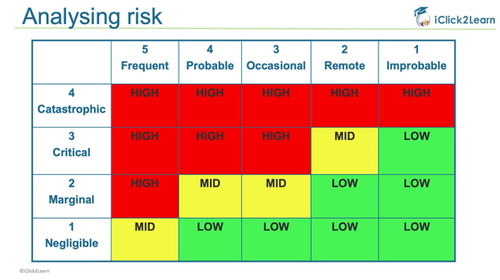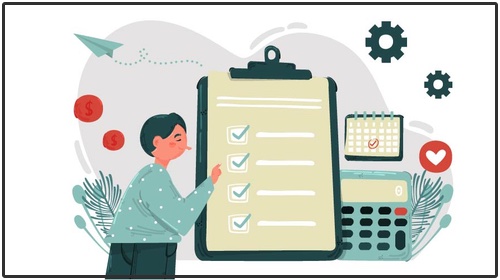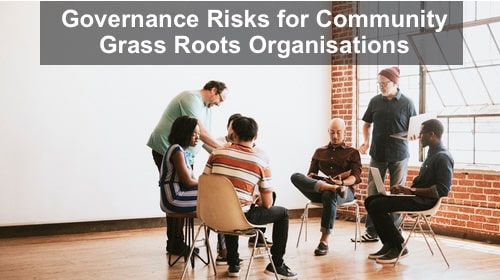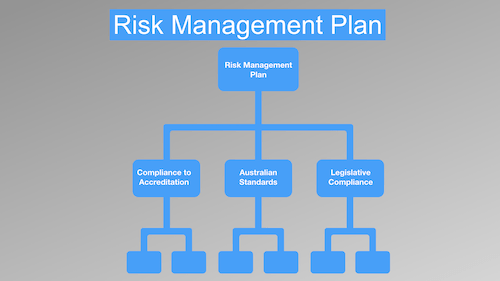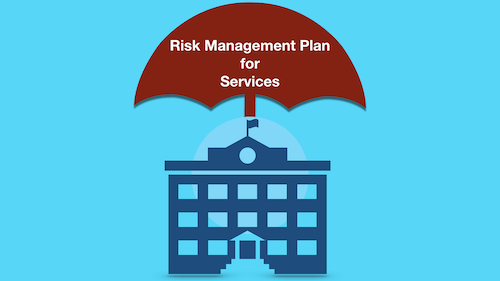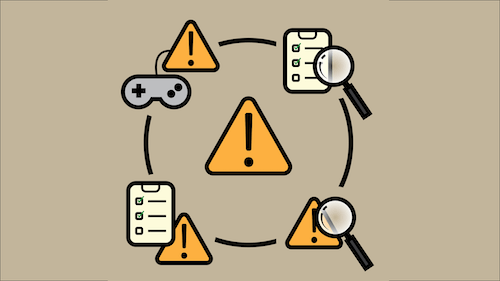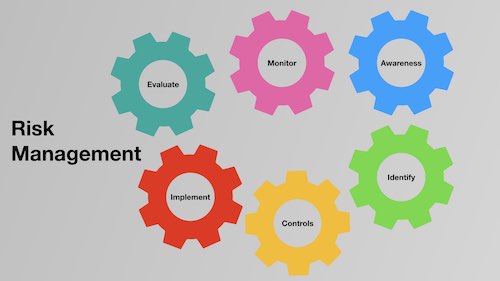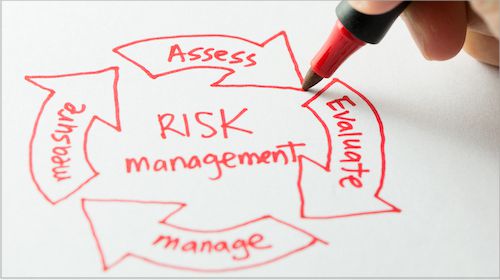Risk Management
Not all risks can be avoided. But a risk management strategy helps your organisation minimize risks to prevent or reduce damage. Watch our governance expert Natalie Bramble as she explains the importance of risk management.
Authored by: iClick2Learn Team
Translate Text
– Alright, so I’ll officially start. Welcome everyone, so glad to have you here. We are talking about risk management today, which I know for some just brings a shudder, but the risk management at its heart is actually about taking care of our people. So, it is a really important aspect, we wouldn’t want any of our volunteers, for example, to be affected or to, you know, for something to happen that affects the reputation of our organisation. So with that in mind, it is really important that we do take space and a moment to think about risk management. Got a bit of an interactive session plan today. We are going to be an event committee and work through a few risks from an event perspective as well. So, you’ll hear from some of the other wonderful members who will join us tonight as we go through. Before we get started, I’d like to pay my respects and acknowledge the traditional owners. I am in the Tubbagah, which is Dubbo, New South Wales. So that’s the Tubbagah, north of the Wiradjuri and I know we’ve got people joining us from all over Australia.
I think maybe, a couple of states missing out, otherwise, we’ve got a few here from different parts of the world or different parts of Australia, I should say so we’ll come along. As I mentioned, risk management at its very heart is about people. So ultimately, when we think risk management, you know it is about process, and it is about documenting, but we do all of that because we want to make sure that we have a sustainable organisation. And one of the key things about risks, and I think you’d all agree, is that everybody has to be involved in this. It’s so easy for me to say, oh, these are the risks for this volunteer, but if I’m not actually doing the job, or if I haven’t observed the risks, then I really don’t know, I’m making a lot of assumptions. So, it is important for everyone to be involved in this. And I think another way to think about this is what’s the opportunity here as well. So rather than thinking from a risk compliance perspective, it somewhat an opportunity to make sure that, you know, everyone’s supported in their role, that everybody’s given the right training that they need, and that an opportunity to keep others safe. So, just some quick simple tips, when we think about, what are some keys to risk management? The first of these is understanding the environment that you are actually considering risking. And I even say, deeply understand that environment because when you think about the different projects or services that you run, events or activities that you run, you need to understand, and when we think environment, of course, it’s the physical environment so where is it located? But we also need to consider the intangible environment as well. So the intangible environment being around, perhaps there’s a cultural piece, it might be, you know, we’re going into, for example, a remote community, so, what’s the environment that surrounds that community and how they operate, as well as perhaps some cultural elements. So, understanding that environment is important from a resourcing perspective as well. You know, what are the resources that support the work that we do in that environment? Who are the stakeholders and engaging them in this process is really important. If you haven’t ever run the taken stakeholder mapping, that’s actually a really good process to use. Stakeholder mapping is basically, you write a list of stakeholders and then you prioritise those stakeholders, this is sort of a simple format you can use, all these tools like matrixes and all that sort of thing. But in its simplest format, you just list all of your stakeholders and you prioritise them in order of their influence or their impact on your project. And, you know, when we consider this, so many of us have other stakeholders like funders that we need to consider as well. And so of course their influence and impact on the project, if they funded it, is quite considerable. And so that’s another example of, how you’d consider prioritising the stakeholders. So, it’s not just about the environment, it’s not just about the physical, it’s just not about how they’re involved, it’s about their influence on your project and your ability to deliver your project. And I’m just going to call that a project, it could be a service, as I said, or a programme or an event, anything that you’re doing, I’ll just use the word broadly, project. So, thinking about who your stakeholders are and thinking about, list them in priority order and then ask, well, what do we need from them? What information do we need from them? So for example, if it was a funding stakeholder, you would want to make sure that you’ve got the funding contract because then you can actually review their requirements, what you have to deliver and consider this in your risks. So that’s an example. If you don’t have those expectations documented or anything, any way you can find them, then ask them. You know, engage them in this process, particularly if they’re your volunteers or your team members that are actually doing the work, engage them in what this risk environment sort of looks like and what they feel the risks might be. We going to talk about processes, it’s really important to have those processes in place and make sure everybody’s aware of those. It’s important to document our risk evaluation. So make sure we have those documents that support the work we’re doing, because at some point, those documents are actually going to be quite outdated and they will need a refresh and a review, and this will support that. But the other reason that it supports it as well, I mean, obviously there’s that sort of legal context, that’s the justification you’ve got that information if anything would happen. But one of the key things for community organisations is this successioning of information. And you know, if we had just started, let’s just say, as an event coordinator, the first thing we do is say, okay, well, what documents are being developed in the past? And so I would be looking for this risk information, and that’s another reason why we make sure that we document it as well. This is definitely not a set and forget exercise, with risks, we actually have to have regular processes in place. So schedule regular reviews. It’s always this thing that I say to everybody, you should have a calendar of activities and you need to create those moments. So if you want to do something, don’t just assume that it’s going to happen, you actually need to deliberately engineer those moments. So, you know if you don’t have a quarterly risk review for your committee, for example, then schedule that. If you know that your event is coming up in October, then work out when you actually want to schedule your risk review with the team. Be it your committee plan, be it, you know with your volunteers. But just make sure that you’re documenting that in the process in that way, you know, it’s sort of a set, that’s the plan and that’s what we’ll stick to. And one of the things that I find that there’s two key elements with risks that I find that are often missed that are actually really, really critical and one of these is triggers. The other is residual risks and I’m going to talk about, more about these as we go through the process and we do some of our own kind of planning. The reason why triggers are important, I’m just going to expand them a little bit so we get the context. How many risks do we have? Like a lot. I’m sure if you went to your risk management plan if you already have one, or you saw somebody else’s risk management plan, you’ve probably got 20 odd risks documented. But the key thing is that you can map a theme for those risks. So you can look at your risk plan and say, well, actually the only reason that risk is going to happen for example, is, if we don’t sell enough event tickets. So if we went through our list and we categorise them into common themes, we’d actually find that five risks are triggered when it’s clear we haven’t sold enough tickets to make sure that we’re covering our minimum expenses to run the event. And so instead of worrying about five risks, what you monitor are the triggers. And so once you go through, when you mark and categorise your risks, you’ll actually identify that, that may actually be 10 risks. And although it’s 10 triggers, you might actually find that there’s really four to six key risks that you’ll actually monitor as triggers. And when they happen, you can then go back to the risk plan and then say, okay, well, which ones match to that what we got to do. So, it really helps kind of get that cut through with all of this information. So you don’t have to worry about 20 risks, you’ve just got to make sure you understand the key risks and the themes, and that you prioritise them and monitor those higher priority risks. And this, I already know this last one, it’s such common sense, isn’t it? Communicate, communicate, communicate, but so often we think we’ve done it, we think we’ve taught someone or we think we’ve shared something and we haven’t. So it’s really helpful to, if you’re the one managing this, to make sure that you have a process for how you do this. And, you know, processes and systems and policies and yeah, like everybody, sometimes I do your head in and you think, oh my gosh, there’s just so much. But the great thing is if you have a workflow, if you have a process, you don’t have to fill your brain with remembering, you can be worried about doing the other stuff. So, get a process in place, that communication piece, if something’s changed, okay, I go back to my process and what have I got to do to make sure I’m communicating. So there’s some real big fundamentals for me when we talk risks. Some keys when you talk about risk management for a more formal process, obviously, it’s about identifying what legislation exists, and making sure you understand how you comply with that. Now, for some of our organisations, legislation is going to be industry standards that affect their accreditation as well, because if they’re not comply with those industry standards, then they may be de registered for example, and no longer out the provide childcare services. So, it’s actually understanding the legal environment that you operate in as well, what do you have to comply with and how do you do that? So that’s part of that risk process. Identifying who’s responsible for what and how are you going to manage resources, that’s always a really important one key to success ’cause if you don’t have responsible people, everyone’s responsible, and as you nothing happens, well, maybe not as much as we’d like happens. It is useful to understand the costs of injury and illness, particularly those with a workforce, people that are on stress leave, worker’s compensation, they’ve hurt themselves, et cetera. So, from a financial perspective, if you do get some pushback from your committee or board about spending money, then talk about consequences of what can happen. And this kind of conversation comes into some of the framework we’re going to look at, which is how likely is it? And then what are the consequences of those things happening? So I’m going to be talking about that a little later, but that can be a conversation point around, you know, if you need some sort of strength to say, hey, we do need to invest in this pace because this is a potential consequences, this what we’re happy with. Obviously having a workplace health and safety system. So, this is about a system and a process that you’d go through a staged process and we’ll be talking through some of those elements tonight and that whole monitoring and reviewing, as I mentioned, and modifying and obviously improving our risks as much as possible. It’d be great if we could, we could mitigate and get rid of everything but we know we live in the real world as well. So, when we think about what causes risks, these are sort of three of the common, most common areas when we talk about risks and why they happen. You know, obviously human error, you know, we’re all human, things happen sometimes we get in our own heads and maybe we forget certain things, or it’s been ages since I was trying on that, and that’s why we need refreshers. We have so much going on with everything else that, you know, it’s quite acceptable that somebody would forget instructions that you’ve given them in the past. So, that’s why that training and constant updating is really important. A really great process for that, and this also, particularly for those of you who have staff, this also meets your legislative requirements. Now, if for staff, it would be making sure that you schedule those regular reviews and updates. And it might be looking at a policy, it might be making sure that somebody has, has read X, Y, and Z, or that somebody would be able to do something. And thinking about how humans learn is also really useful as well. So there’s a way, a number of ways that you can do this around making sure that they understand. And it’s more than just saying, oh, yeah, I’ve got the policy I’ve read it and understood it. What if they had to do a presentation to your team? And this could be volunteers as well, so as a volunteer rep manager, for example, I might be doing a presentation to the committee about what risk management is, why it’s important in what we’re doing. And that really does give you an indication that that knowledge is transferred and I do understand it. So, that can be actually really helpful and that can help minimise human error. So instead of telling people, we’re enabling them to do. Once people do, they get a greater understanding. So, that can particularly help. And I’ll give an example of how we do, we’ve just inducted a new staff member a couple of weeks ago, and the first thing, you know, sort of the first day is about workplace health and safety, that sort of, the key thing and understanding that. But what we actually get them to do is they own task and environment risk management plan. So, they’re guided and coached, but they’re actually completing it, and they’re having discussions about that risk management plan. So, we understand, of course they understand how to do one before they do one and their coach, but ultimately they’re the ones doing it. And so that is then going to reduce the human error component. So that’s a really great thing to think about, how do you help them show and do rather than to help. Equipment of course, yep, definitely. The amount of the old slow cookers that burst in kitchens and in some cases, unfortunately, you know, people were affected or burnt which was not great so, there are faults in equipments. These are things that, you know, as much as possible, of course you can plan for and you can mitigate, but ultimately faults in equipment, things like that, we’ve heard a number of them over the years, their things that happen. So, what you can do though, is you can plan for things like checks, equipment checks. And so if we have equipment, it’s our responsibility to make sure it’s still safe and it’s still usable. So what we do is we schedule regular checks of that equipment. So if I was using a generator for the event, it’s not turning up on the day of the event and all of a sudden it doesn’t work or worse yet, something happens and somebody is hurt. So, it’s about making sure we schedule those regular checks and that’s what we can do in terms of risks. And of course the other ones is those environmental conditions. I’ll talk about the rule of three reviews well, we said quite a lot of things actually and it’s like, you can have the most perfect processes and systems, you can have the most perfect infrastructure, but if you add that third element called human, it can all look different and it looks different to different people. Different things mean different, have different meanings to different people. So, it certainly needs to be, I think that’s one of the most important reasons why we should involve a lot of different people because we get this environment of, of people that think differently, they’re contributing and they’re, I’m sure you’ve been in those meetings where you’re like, oh yeah, I hadn’t thought of that. And then you can start talking about whether yeah, we should plan for that or not. I just thought of a funny one actually, but I’ll share a little later for an event that I was involved in, many, many years ago, I was a youth volunteer. So when we talk about failure, it can come down to, in essence again, these are sort of common buckets or common things if you like. Individual failure where, people don’t know, they’re not trying to, they can’t remember et cetera, it’s that human factor we talked about, but there’s also that leadership failure as well, it’s really that setting the standard, oh, that’s okay, now he’s not doing that, so I don’t have to do that. So, it’s walking the talk every time. And some of the why’s that walking the talk can happen is, you know, at regular team meetings, volunteer meetings, or staff meetings, we’re talking about it, we’re raising that. So, for those leaders listening to this, it’s not about asking everybody else about what risks they may have identified, or what’s changed, perhaps leading a conversation about that can be a really good indicator. That training piece, again, you know, they’re not trying to know the standard and the standard is your standard. What your standards are, when we talk about standard here, so, what your standards are and how you approach risk management. So they may not, you know, they may know that there’s a risk, but they may not know what to do because they don’t know, you know, okay, well, I’m supposed to go and report it, or I’m supposed to go and fill this form out. But where is the form? I don’t know. So there are these steps in the process that those breaks can create failures. And of course, then there’s the support so they might not have the appropriate equipment to deal with it. In the days of COVID, of course, you know, face masks, I’ve got to go out and deliver meals, but I don’t have the proper equipment to do it so, perhaps, people need these meals delivered and so you say, people making decisions about, those sorts of things all the the time. So they’re ’cause there’s some general ones around failure. I wanted to talk about negligence for a minute in respect to this piece. And it’s just, I’m sure those of you who are reading it or had, sorry, who were joining us and watching the recording, you definitely know, you know, you’re interested in your risk so, you know it’s important. But we do also have other people that are like, ah, you’re right. It’s all right, don’t worry about it, you know, it’s never happened before, it’s okay. So, you know, it is important, this is another kind of good strengthening piece to share with them and that’s around this piece around negligence. Sometimes legislations like the big stick that you made, you try and get people across and involved in this with carrots, you know, and motivate them and get them, excited about, oh, but this is going to be great. You know, if we manage these risks, this means X or this is an opportunity to do X, but sometimes unfortunately it doesn’t work and you’ve got to do the old stick which is yes, well, did you know that you were legally responsible? And so this is this piece around negligence, it’s not okay to say that ah, we didn’t understand the risks so we didn’t know the risks. There is a duty of care to make sure that everyone in the organisation is fully aware and understands this. And you’ve only got to look at, some of you will be aware of the change in the risk environment and to give you a quick run through, a few years ago, it used to be the person at the top who is the most responsible person, but that changed, and we now have this flat structure where everybody’s responsible. So, you know, in state legislation where you sort of have some, the majority of states have what we call Harmonised Legislation and Workplace health and safety so, it’s about everybody being responsible. So, negligence occurs when we know that, and actually I’ve got some full factors I’ll run through for you, and this will be on the recording and certainly screenshot this and send this off. So here we go, this is why it’s important. If these four things exist, which is a duty exists, so yeah, we’ve definitely got a duty of care. The duty is breached, so if we were found to have breached our duty by not fulfilling our duty of care and an injury occurs. Now, when we talk injury, it could be something like a reputational injury, it could be a financial injury. An organisation that I’m supporting at the moment, for example, is going through a process around some defamation which talks about a financial injury, so that’s an example. And that there is a breach of that duty, so it can be directly linked. It can be the injury, what’s occurred can be directly linked to the fact that you’ve breached your duty and that can be proven. So, if those do exist then yeah, we may be deemed negligence. And of course, negligence for us creates this whole challenge then around the fact that we will be dangerous deemed responsible and so that’s, you know, that label pace. So how do we do it? I want to talk about the first one, a little while about risk-taking. I talk about it in terms of what’s called a risk appetite. So we’re going to get to that, and I’ve got a visual and we’ll talk through that when we get there. But it is that balance because we can’t mitigate everything, you know, you can’t spend whole heap of money and just change the whole eventually or change whatever it is. So it is about that practical application. So it is really that balancing act for many, particularly when we talk about the community sector because we’re operating on a zero base budget. Understanding key risks, this thing about risk appetite which I’ll talk about in a moment, implementing the framework, making sure that, everything that you do, this is a really good point around embedding considerations for risk. And so when you think about those key points when you make decisions in your organisation, do you have a title called risk? On a decision-making point, De Bono Six Thinking Hats is a good one to use anyway, it doesn’t include risk, but it includes things like, you know, finance innovation. So that’s Edward De Bono Six Thinking Hats. It’s a really great process for decision-making. So think about your decision making processes, your checklist, whatever it might be, and just make sure you go, okay, hang on, have we thought about the risks? And of course, reviewing plans and adjusting. So critical factors, definitely leadership, you’ve got to adjust culture and equitable culture, there are very clear rules for, you know, we expect this from you as a volunteer, this is the kind of the competency that we expect. Also, clear rules I’d say, I’d add around consequences. If you don’t do this, what does that look like? And, if we’re talking about staff that could be retraining, for example, making sure we’ve got risk reporting mechanisms so that, you know, committee meetings where we’ve got that on the agenda and we’re actually reporting and they’re being listed. And if I need to be, they’ll also put in our risk register. There’s the appropriate structure and line of reporting. So as a volunteer, I know who to go to, another person to speak to, or who I need to share this information with. It’s very clear. And there’s also opportunities, and when I say opportunities, these are about designing those points in time when you ask them for input, not just waiting to hear from them. A number of times where people have done, oh, yeah, well, I thought, yeah, I speak that up, that risk up weeks ago, but I didn’t think to tell you. So if you’re designing those processes, it’s just kind of reminding them, oh, actually, thanks. I’m glad you asked because x, y, and z. Making sure we’ve got the right resources, so, you know, having people trained, and investing in that, making sure if you had to investigate something, you’re feeding back to them and of course that any corrective actions you take are implemented and monitored and changed. So, let’s have a look, I’m going to share screen. I’m going to talk through the process and feel free to jump in here as well if you’d like to, join for those of you who have gone through risk management process. And hopefully, I included this in the chat, so hopefully you should be able to download that. For those watching the recording, the files will be underneath the video, about 12:01 I shared those, okay. So what does happen, give me just a second. What does happen, I’ve noticed on the wonderful zoom. It’s not like the webinar platform we’ve been using, is that only those people that come in at that time get to see them. So if it’s been shared earlier you can’t see it. So let me just do those again. So you should have now be able to see two files. Brilliant. So the one we’re looking at is the PDF, and this is sort of the process for what you’d go through. You know, that establishing the context which I mentioned earlier. So that’s sort of that environment piece. It’s an important one around developing criteria, particularly if you’re talking about programmes, your running, perhaps with other parties. Well, where does, where’s the line between what your responsible for and what your partner’s responsible for? So you might need to almost develop a little bit of a map of those responsibilities. I’ve just been doing this actually with a consortium this week or this last week with about 10 different organisations involved. And it really is about being very, very clear about what is under your control and you’re responsible for, and what they’re responsible for. In this environment, we have this continuous kind of cycle of, communicate, communicate as Matt has shared yet communicate, right? Communication break down is that, that sort of human error piece, so, communicate, communicate, and obviously monitor and review. So once we understand the context, we then identify risks. We’re actually going to do this with an example. I found a very old risk management plan for the Christmas Fair. So, we’re going to walk through that one and have a look. We then analyse risks, and that’s where you generally say that, you know, a nice coloured sort of traffic light, table with the green risks, you have sort of yellow, orange and your reds, and you determine where they fit there and we’ll have a look at that in a moment. You’ll then evaluate them, so compare them against the criteria. So the criteria, it’s really about prioritising. So for a lot of community groups, it’s about prioritising the resources you have, how critical it is to treat that risk, as well as the consequences and the costs to do that. And then you’ll treat the risk. In some cases that met my, and I’ll talk about treatments, but it could be, you know, okay, well, we’re not going to use that particular thing, or we’re not going to have that, use that particular room for the event or even that venue. And then you talk about trading risk. So it’s a fairly standard flow, you’ll actually sharing a very similar one in the Australian standards for risk management. So, it’s a pretty straightforward risk management process there. So what we’re going to look at is, oh, I’ll just share my screen again. There we go. So we going to look at the evaluation piece around risk. You should be able to see the slides there, I’ll just double check in chat, I’ve shared the right screen, beautiful. So what we’re doing here is we’re saying, okay, if we’ve got a risk, we need to decide how likely it is that the risk is going to occur. And, you know, I’m sure in nearly every risk training, the whole COVID comes up, you know, we never felt that would affect us. I’m sure that’s the one that’s shared. So, we might think it’s unlikely that it may occur based on of course, past evidence but we also need to think about, again, it comes back to the environment. We also need to think about the future as well and I’m sure there’s a lot of groups rethinking a few things, particularly if we talk about events which is one of the ones I’ve used ’cause it’s a very broad kind of example. So we think about how likely it is and we give it a rating, we’ll look at that writing and the next slide. And then we think about, you know, what are the consequences? So if this happened, what’s the impact? What would be the result? You know, venues, for example, a lot of venues don’t allow candles, you know, it’s okay if it’s electric, but they won’t actually allow fire, no candles that are on fire. Of course, because they can see that the fire damage you risk to be too significant. So you look at the likelihood ratings. So for example, if we have a look at this one there’s five levels. So we start with, you know, it’s improbable or highly unlikely you might say. It’s very remote, rare that it might happen. It might occasionally happen, which would be a number three, four, would be here it could happen, it’s probable, not frequently but it could happen. Maybe it’s sort of something that we expect to happen once every couple of months. And then of course the five years is the, yep, happens all the time, so, it’s a regular risk we deal with. And then you rate it to the severity and the consequence. Now, these are numbers, this is a standard process. This is another, I’m going to bring up another common missing element when we talk risks. The number of risk management plans that I see that have severity and consequence and they say, yes, let’s just, you know, if we look at these five and ’cause I’m going to read maps to, for visual purposes to support visual impairment as well as the people that may be, just listening in on the video. One is negligible, you know, it’s very minor. One might be, yep, it might be marginal so someone might be sick for a day, for example, or it could be critical where it could cause injury or catastrophic, which could be resulting in a loss of life or loss of significant elements and, you know, it could be financial as well. These aren’t just talking about injury and illness, but this relates to financial as well. So significant financial or catastrophic financial loss might be, we just lost our long-term funder that gives us 100, 000 a year. Now that’s huge. So one of the things here though that often is missing in risk management plans is, if I’m looking at this, I don’t know what you, if you’re using this kind of ranking, I don’t know how you personally determined that it was critical if I don’t have some guidance. So if it’s a financial risk, for example, which I haven’t included here, ’cause I wanted to use this as that, what does critical mean? Does that mean that we’ve lost $5,000? You know, what’s critical? Does it mean that we’ve lost a percentage of our income? So, we need to make sure when you’re looking at these risk frameworks and we’re analysing them, that anybody who picks it up can understand straight away what we’ve used to categorise the risk in that area. Because otherwise, what we end up with is we end up with, oops, what we end up with is, you know, risks that somebody has said is critical, the other person thinks, oh, that’s not really critical, I’m going to make that a marginal actually because they’re using their own judgement . But if you’re using those parameters to say, yeah, actually it is critical because of X, then they’re more likely, everyone’s more likely to be more aware of that as well. Okay, so once you’ve kind of assigned a value in a criteria, this is sort of the process that you would go through. And now I know that the chat works, I’ll probably actually email the slides to you so you’ve got them I know you can get files through the chat, I’ll just have to PDF them. You then go to, we’ll come back to that other one, you then go to the sort of analysing risk table, which is a risk table that I use in training when I deliver training for an Institute of community directors in our community. And it’s just a general risk table, you can get these from anywhere, you could jump on the, you know, great, there’s a great website for volunteers which is, and I’ll send the link through as well and put the link down below. But workplace safety’s such a great link, obviously you’ve also got state-based workplace safety regulators as well, but this is kind of generally what it looks like and you basically, put that risk where it belongs. For some people, visuals are great. I’m quite a fan of the old spreadsheet personally, which I will bring out ’cause that’s what we’re going to do next is, we’re going to have a look at an example. So, I’ll just I’ll just bring that up. So this example, and we’re going to talk through, this example. Everyone loves a spreadsheet. Yeah, I do know people that don’t love spreadsheets, but I’m a bit of a spreadsheet fan I have to say. So the example we’re using is we have taken over the Christmas fair. This was a very, very old one. This was actually, I manage that Christmas fair, oh, I don’t know, it could be 15 years ago that I did this. So, let’s just say we’ve taken over that. I came across it and I was like, oh, perfect. I’ll use that one ’cause it doesn’t have, it doesn’t have any current, any current information in it. So when we look at the risk register, we’ve listed a few things here. We’ve started listing a few things here and feel free to, to jump on as well on audio if you want to jump in, but, or pop it in chat. But we’ve listed a few things here and you can see we’ve got probability, we haven’t actually filled out impact. So, it’s an outdoor, just to make sure everyone understands it’s an outdoor event at a park in Dubbo. And it’s still like, well, it’s still kind of happens, maybe it’ll be up for this year, if not, it’ll be back next year ’cause it it’s actually run by Rotary or a couple of Rotary clubs that are, that run it as well. So, what’s the risk do you think will the impact of inclement weather? You know, if it rains, the impact would be, what are we thinking? See, if we looked at that one to five significant, catastrophic, minor, ’cause we haven’t treated the risk yet. So let’s say that we consider it to be, minor and we know that rain, hail or extreme weather might trigger the event, so what can we do? We can change the venue or offer wet weather equipment to stallholders. So if we want to keep that venue, so that’s an example. What are some other things we might be able to do? Yeah, beautiful. If it’s significant, we would cancel it. So do you think we’d have it, if it was hailing, do you think we’d have the event outside? Probably not. Change the venue to perhaps indoors or, because what I use to run the farmer’s market in same venue, or perhaps the RSL undercover car park. So, that might be, I will get rid of rain ’cause if it’s rain that’s fine, we change the venue, we offer wet weather but if it’s hail or extreme weather given the time of year, given it’s in Dubbo, it’s probably a very low risk ’cause it’s in Christmas, it’s more likely to be heat. That’s going to be the issue than rain or hail. So this is, you know, just kind of showing you a very quick example of a risk plan, it’s a very simple one. The key thing is it has those trigger events and trigger into cadence. So you categorising them, you saying, well, what is it that’s going to trigger these? And then you would, you know go through, you would list all the impacts, you would do the triggers, and you would categorise and sort it by triggers and they’re the things that you would, make sure that you’re monitoring. But there’s one thing missing from this risk plan and I’m going to, oops, not quite what I wanted, I didn’t want a column there but it’s all right. I’m going to add another column here and the other column I’m going to add is called residual risk. So what a residual risk is, once you’ve treated the risk, you actually need to ask yourself, okay, if we do that, is there going to be a greater risk? And just using this example, let’s just say that not only is it rain, it’s also high wind. So if we’re offering wet weather equipment to stallholders, for example, we’ve got, you know, those sort of four by four tents and they’re not weighted down, well, that could actually offer another risk or a higher risk, particularly if the wind picks it up and knock someone over, you can see where I’m heading with this. A typical one I always say, well, not always but it’s so common is when I’m running a face-to-face workshop, I turn up and I say, oh, that’s okay, we’ve got a match to go over your leads, your computer and projector leads, and we’re like, oh, that’s great. It’s just a bigger area now for me to trip over.
– Sure.
– So those residual risks are really important, really important that we say, it’s always good we’ve thought about how to trade it, and we thought about what we’re going to do, but hang on a moment, even that treatment, has that actually created a bigger risk for us? Is this going to be a bigger problem than what I actually want? And, you know, on the treatments of risks, there’s a couple of things that we can do, we can of course remove the risk if possible, you know, get rid of it, don’t use that venue for example. We could substitute it, so instead of this protector, we’re going to use that projector. We could isolate it, so that might be keeping it separate. We just need to take care of, and just on the Christmas theme, Christmas fair theme, I’ll give you an example of where someone said, oh yeah, that’s okay, we’ll just isolate that area and that was some children’s games. And I said, well, that’s okay, We’ll just build a structure around it so the kids can be over there, and so they’re not throwing balls into the crowds, etc. But in that case, you’re creating definitely a residual risk because now you’re creating a space where you’re in charge and in control of children which creates child safety and increased issues. How we mitigated that was we actually got a childcare centre to run that part of it and so that mitigated the risk. So, you know, yes, we had a risk, someone suggested we do this, but the residual risk was X. So to mitigate that residual risk this is what we did. So, talking it through just made sure that we’re really putting those processes in place. Engineering controls, that’s mostly with materials, equipment, etc. So things like PPE gear, if you’re delivering for males on whales. You know, there’s the administrative controls, which has changed the way that you do things and of course your personal protection equipment. So they are the typical whys that you keep, you know, that you mitigate risks and that’s place-based risks sort of environmental risks as well as person risks. Probably the last thing I want to talk through and share with you is, a bit of what we call a risk appetite statement. And it’s just about, this is sort of a visual example of this, and it can help you to have conversations. I actually, generally it’s blue there, but you could actually make it orange or yellow and call this your traffic light system. So a traffic light system is a really good indicator for anything that you’re monitoring or measuring to say, for example, I’ll use financials, a really simple one to use, it’s within budget, it would be great. If it’s likely that we’re not going to get that funding and it’s a low impact to the budget, let’s just say it’s $500 then, you know, it might be, yellow because, you know, we were counting on that $500 to pay for, the stage or whatever it might be. But then the red area is okay, it’s out of control, we’ve got big problems, we’ve got to talk them through. So traffic light processes are actually really useful as a framework for you to talk through. It’s not just risk, it’s your financials, your reputation your, you know, how things, how project’s on track, there’s a range of ways that you can use this. And so what you would do with risks is you would have conversations. And with risks, let me ask you this, when we think about risks, what types of risks might there be? So we’ve got financial risks, what are some other risks you think? Feel free to talk or to pop them in chat. What are some other,
– You said reputation?
– Yeah. Reputation. Yep. Yep. Definitely. Definitely. So financial reputational, we’ve got human, tasks sort of focused risks. The doing types of risks, held up risks. So we got strategic. What about strategic risks? If we decide to do something, is that going to take us off our purpose?
– Health risks.
– Yeah. Yup, yup.
– And the third party risk of the people that you’re potentially trying to help. So you might be fundraising for a course. So you’ve got the risk to yourself while you’re fundraising, but you’ve got the risk of not being able to support or do what you would, the outcome was supposed to be.
– Yay. Yeah, definitely. So there’s, I mean, you could literally sit down and document, and this is a useful thing to do in this process because when you go through analysing risks, this, having kind of a checklist of different types of risks helps you to go, oh, hang on. We haven’t thought about that. does this apply? And, and it just helps the thinking. And so if you go through, when you think about what some of those categories might be, you can use this visual to then talk through with your team. If we thought about reputational risks, obviously, great. Everyone’s happy. There’s no problems which we’ve got. Maybe we’ve got complaints, but they’re very minor, process compliance, perhaps. Like, I don’t want to pay that membership fee. Toughs, sorry, that’s the membership fee. If you’ve got a massive amount of them and that’s the amount of compliance saying, no, we’re not paying the membership fee. Well, that would be the red because you’re risking losing all of those members. So that’s, that’s an example. So you can use this to sort of talk through what some of those might be. And what this also helps to understand, particularly if you’re involved or in charge of running a funded project. And you’ve got to report to the committee or report to the board about where you’re up to with things. This actually helps you identify what to tell them in your report. And that also helps you cut down on those pages and pages of information, sometimes that you get as big on report, You’ve got a five page report. Well, that’s okay, but really I don’t need to know all about these two paragraphs. So, you can use this process to say, if we’re on track and it’s green, don’t worry about it. You just, maybe, unless it’s a good story to tell me because that always motivates us. That’s awesome. But otherwise I don’t need the story about the green stuff, but if it’s the, if it’s the orange zone where it’s a bit of a concern, it’s under control, but there’s a little bit of a concern. I just want to raise that with you. So you’re aware, if it does go to rant, at least you’re aware now, that’s fine. Give me notes about that. But if it’s a red and depending on the level of red, it could be at, okay, we’ve got to have a meeting and we have to talk about this particular thing, and only this thing. And so that risk appetite can really help in defining what that looks like. And then what you do with that is you can then put that into a bit of a structure. So everybody knows what’s red, what’s orange, what’s green. So I hope that that has helped. I’ve also provided in the tools. Just a simple word document that everybody can use. And I’ll just bring that up now, and just quickly show that and just talk through it. So everyone can, it’s sort of a good starting point and it’s in words so that you can change it, modify it, do what you like with it. And, and it’s just, a risk management checklist that basically does all those things, but it gives you some extra little pointers along the way. So, they’re what, we’re already seeing now, some of those categories we talked about earlier, financial risks, strategic risks, operational risks. And then there is that coloured diagram, that we’ve looked at as well. So if we map it in this case, they’re prescribing they’re using is, A B C, et cetera. And in this case, if we mapped it and if it isn’t in the red, again, sometimes these are really good for visual people that, they’re not list people. They just want to see it visually, and you can demonstrate and show them why we need to do something, because it’s in that red zone. So, that’s just a very simple one, that you can use as well. But there’s also some, there’s a lot of great tools and resources on that. I’m just going to get that website for you. safeworkaustralia.gov.au. And they’ve got a range of fantastic resources on risk management and particularly around volunteering. So you’ll actually find a section, so, safeworkaustralia.gov.au have some fantastic resources.



